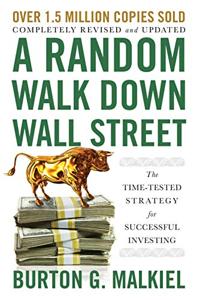
Want to learn the ideas in A Random Walk Down Wall Street better than ever? Read the world’s #1 book summary of A Random Walk Down Wall Street by Burton G. Malkiel here.
Read a brief 1-Page Summary or watch video summaries curated by our expert team. Note: this book guide is not affiliated with or endorsed by the publisher or author, and we always encourage you to purchase and read the full book.
Video Summaries of A Random Walk Down Wall Street
We’ve scoured the Internet for the very best videos on A Random Walk Down Wall Street, from high-quality videos summaries to interviews or commentary by Burton G. Malkiel.
1-Page Summary of A Random Walk Down Wall Street
Introduction
Would you benefit more from actively managing a portfolio of stocks and securities or holding index funds that follow the market? Although professional financial advisors might try to convince you that their actively managed funds outperform index funds, they make money in other ways such as high fees, trading costs and expense charges.
In contrast, economist Burton G. Malkiel advises buying and holding a diverse index fund or collection of index funds that follow broad stock market averages. You’ll learn more about these funds in the following sections. Research shows that this strategy yields higher returns on investment (ROIs) over the long-term than professionally managed funds that charge extra fees.
If you invested $10,000 in a fund that follows the S&P 500 and reinvested all your dividends for 50 years, you would have almost $2 million. If you invested in an actively managed fund instead of following the market’s trends, it would be worth about $800 thousand. Therefore, investing in an index is better than putting money into a managed fund because it’ll yield greater gains over time.
While Burton’s advice has remained the same over the past few decades, there are an overwhelming number of different investment products available now. It can be hard to know where to begin when you’re faced with so many options. This book offers a thorough analysis of these newly available financial instruments and how they can be used in combination for greater returns on capital if you know how to use them correctly.
Stocks and Their Value
In reality, you don’t need a degree in economics or to subscribe to 10 different economic reports. The stock market is complex and full of hedge funds and complicated derivative instruments. However, there’s plenty of room for the average investor to accumulate a substantial nest egg — especially if they avoid hiring overpriced fee-happy financial planners.
A random walk down Wall Street is meant to convey the idea that stocks chosen randomly are likely to do as well as those carefully selected by experts. Decades of studies have proven that indexes, such as the S&P 500, produce long-term growth and steady returns. You don’t need someone else making your financial choices for you – pick products based on your age, income preferences and projected retirement date.
There are several reasons why broad, market-based index funds can be a good idea for long term investors. They’re easy to understand and require very little active management by the investor. They also allow you to avoid some of the risks associated with individual stocks and securities like fraud or poor performance. These types of funds are often based on trends that have been proven over time instead of being based on hype or speculation which is more likely to fail in the future.
A perfect example of this is the Dutch tulip bulb craze that began in 1593. Wealthy people were fascinated by these bulbs and used them to show their status and taste. The more colorful or bizarre the bulb, the more expensive it became. People from all walks of life began speculating on the market, investing vast sums to obtain bulbs they believed would make them wealthy beyond belief once they were traded. They sold off land, furniture, and even jewels to buy rarest bulbs they could find. But then suddenly there was a crash in prices as most bulbs sold for about what an onion does now.
There are many factors that can influence the market, such as technology and real estate. In the early 2000s, there were two bubbles in these markets. Investors should be aware of this when they’re investing their money in these types of situations. It’s hard to know if an investment is a good one or not because everyone wants to invest in them because it seems like a guaranteed profit. However, people need to keep in mind that throwing your money into speculative bubbles never pays off long-term because you may lose all your money depending on how much risk you decide to take on at first.





